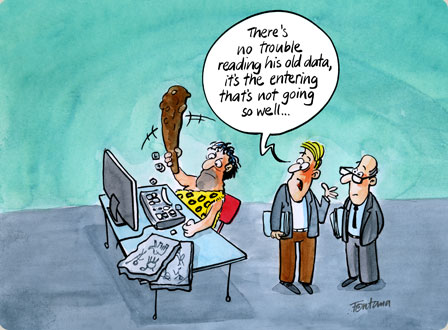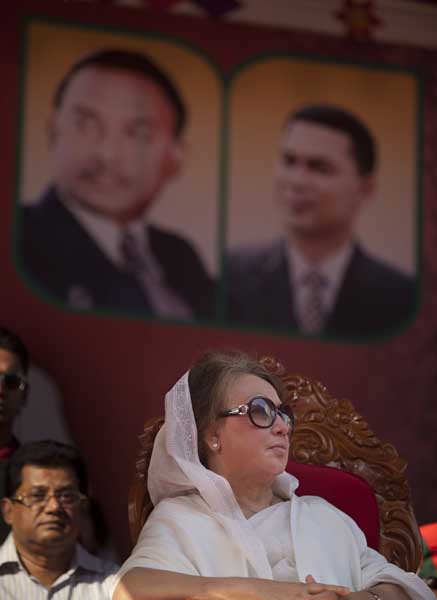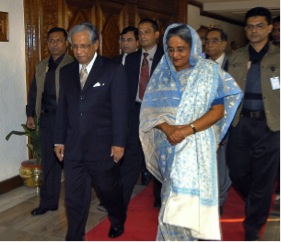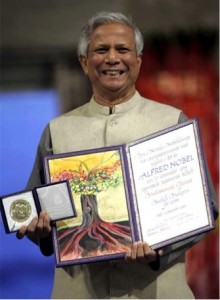Article that looks at the rise of digital Bangladesh culminating in the current blockage of www.youtube.com in Bangladesh.

Remember those days? It was 1993. Getting a new telephone line took several years and large bribes. Getting an international line was another matter and calling overseas required making a ?Trunk Call? through an operator and a wait of several hours. Phone calls were expensive. A one-minute fax or call to the US cost well over 100 Taka. The exchange rate was very different, and a 116 Taka one page fax would have set you back three US dollars! We needed government permission to import a fax machine and the clunky early generation mobile phones cost over one lakh each (US $ 2,500). It was less than twenty years ago. Now, Mobin, the guy in our mudir dokan (corner shop) downloads videos from my blog (where he is featured) on his mobile phone. We get news on TV sandwiched between gyrating boys and girls advertising FnF connections. My attempts to curb Facebook use at work has failed miserably. We finally have 3G, at least partially.
How did this digital revolution come about? We had decided to set up our picture agency Drik, not in the established photographic marketplaces of London, Paris or New York, but in Dhaka, where our photographers were based. But while we were close to our photographers our distance from the market, in terms of miles and means was enormous. What we also wanted to do was to set up a South-South exchange, so we could build on our collective strengths. A Dutch organisation called TOOL was interested in publishing my book, and I decided to meet up with them while in Amsterdam for the judging of World Press Photo. Researching on them I discovered they also offered off-line email, using Fidonet technology. More importantly, they too were keen on setting up a South-South exchange. Continue reading “When luddites go digital”
Category: Caretaker government
March 12 Rally

The government was hell bent on preventing the opposition rally. Trains, buses and launches were all stopped. Ordinary passengers were beaten up and prevented from off loading at stations and ferrys. The police were out in full force in the city, checking on people to make sure they were not opposition supporters heading for the rally.
Continue reading “March 12 Rally”
CONCLUDING PART Military-installed caretaker govt, or a 'consortium' govt?
by rahnuma ahmed

As I conclude my series on the consortium government, I’d like to let my readers know that what I’ve been writing (7 parts, this included) was a mere scratch of the tip of the iceberg. That, since the more I delved, the more intrigued I became, I have decided to continue my research, and will probably write about some of the themes later, in these pages, after having examined them in greater detail.
At a more general level, I have argued that terming Fakhruddin’s regime as a “military-installed caretaker government,” which, when it had been coined, had helped to unmask the character of the regime, had helped to expose its repeated objectives of “strengthening Bangladesh’s democratic order” (Fakhruddin) http://tinyurl.com/39pheg as being rhetorical moves concealing ulterior motives, but however, that, a critical look, aided by hindsight, leads me to believe that one needs to further our analysis, that forces which were then identified as being supporters of the regime, i.e., shusheel shomaj, and western diplomats, were intrinsic to the regime, formed its constitutive elements. Continue reading “CONCLUDING PART Military-installed caretaker govt, or a 'consortium' govt?”
Part VI Military-installed caretaker govt, or a 'consortium' govt?
by rahnuma ahmed
Yesterday, I had ended with the words, “there is still hope.”
But, of course, hoping doesn’t mean that one daydreams, or fantasises. Or, becomes cynical when things don’t turn out the way one had wished.
“Pessimism of the intellect, optimism of the will” — words attributed to Antonio Gramsci, the Italian Marxist, imprisoned by Mussolini. To see the world as it really is, underpinned by the will that humans have the courage to change it. One thus needs to dispassionately examine what occurred later. But before doing so, let me turn to the cat- out-of-the-bag story.
The ‘minus two plan’ was officially confirmed by the World Bank South Asia vice-president Praful C. Patel. While visiting Dhaka, at the end of 2007, he said, “What [had] looked possible before, like the minus-two approach, does not seem possible today, because the two ladies have [a] very strong and powerful power base.” Continue reading “Part VI Military-installed caretaker govt, or a 'consortium' govt?”
Part V Military-installed caretaker govt, or a 'consortium' govt?
by rahnuma ahmed
Dr. Muhammad Yunus, proud recipient of The Nobel Peace Prize, 2006, which was awarded jointly to Muhammad Yunus and Grameen Bank, which he founded, “for their efforts to create economic and social development from below.”

I had written earlier in this series that now, when I look back, it seems that the policy planners of the consortium government had almost arithmetically calculated that a ‘political vacuum’ resulting from minus-ing the two leaders, from dismantling the organisational structure of the two major political parties — would create the enabling conditions for redrawing the terrain of politics in Bangladesh (divorcing it further from the issue of national sovereignty) in a manner so as to serve, and further perpetuate, the interests represented by the western power bloc. Continue reading “Part V Military-installed caretaker govt, or a 'consortium' govt?”
Part IV Military-installed caretaker govt, or a 'consortium' govt?
BY RAHNUMA AHMED
But let me return to the central question: is it reasonable to claim that western governments were directly involved in the consortium project? That they were, as I argue, not only one of the constitutive elements, but the leading one?
Some may reply that the presence of the Coffee Group (generally known as the “Tuesday Club”), the frenzied activity of its members prior to the consortium coup, and after — settles the matter. That, the evidence of their activities is well-documented in both print and electronic media, that it is considerably strong, and that convictions on the basis of far less circumstantial evidence have been awarded by courts of law, ones that enjoy credibility.
A WikiLeaks leaked cable dated January 11, 2007 (Subject: Diplomats Coordinate Strategy On Bangladesh, Reference ID: 07DHAKA53), signed by Patricia Butenis, then US ambassador to Bangladesh, describes the Tuesday Club thus to her superiors in Washington, Continue reading “Part IV Military-installed caretaker govt, or a 'consortium' govt?”
